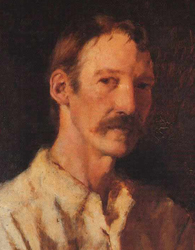Although weak in health himself, Scottish writer Robert Louis Stevenson will always be associated with vigorous adventure, thanks to such thrilling tales as “Kidnapped” and “Treasure Island.” He also achieved international fame for his chilling (and subsequently oft-imitated) Victorian horror story, “The Strange Case of Dr. Jekyll and Mr. Hyde.”
Robert Louis Stevenson’s Early Days
Robert Louis Balfour Stevenson was born on November 13, 1850, in Edinburgh, Scotland. Stevenson was the only child in a prosperous family, but tuberculosis made his childhood difficult. In spite of long absences from school due to illness, Stevenson entered Edinburgh University when he was 17 years old. Pressured by his father to become an engineer like him, Stevenson knew he wanted to write, but agreed to study law as a compromise. However, he would never practice professionally. During his time at university, Stevenson became increasingly interested in the artistic subcultures in Edinburgh. In 1873, Stevenson’s health worsened, and his family sent him to the French Riviera to recover. During this time, Stevenson began to publish critical essays and short stories. Stevenson would spend a lot of time in France over the coming years. His travels in the 1870s provided the bases for some of Stevenson’s earliest published works, including “An Inland Voyage” (1878) and “Travels with a Donkey in Cevennes” (1879).
Sources in this Story
- Biography.com: Robert Louis (Balfour) Stevenson Biography
- The University of Edinburgh Alumni Services: Robert Louis Stevenson (1850-1894)
- Famous Poets and Poems: Robert Louis Stevenson Biography
- National Library of Scotland: Robert Louis Stevenson
- UNESCO: Index Translationum Index
Stevenson’s Notable Accomplishments
While in France in 1876, Stevenson began an affair with a married American woman named Fanny Vandergrift Osbourne. In 1879, Stevenson followed Osbourne to America against his parents’ wishes. After Osbourne divorced her first husband, the couple were married in San Francisco, and then Stevenson brought his wife home to Scotland.
Stevenson spent the remaining years of his life moving around the world in search of a climate that would be compatible with his poor health. He began serializing “Treasure Island” in 1881, and the publication of “Treasure Island” in novel form in 1883 brought him international fame and success. Stevenson followed his debut novel with the popular “The Strange Case of Dr. Jekyll and Mr. Hyde” (1886), “Kidnapped” (1886) and “The Master of Ballantrae” (1889). During this period, Stevenson also published “A Child’s Garden of Verses,” a book of children’s poetry.
Stevenson took his family back to America in 1887 after his father’s death. In 1889, his continuing quest to find a good climate for his weak constitution brought him to Apia, Samoa, where Stevenson settled on an estate with his wife, mother and stepson. Stevenson continued to write, publishing dozens of short stories and articles about life in Polynesia. His novel “The Ebb-tide” (1894) and his unfinished novel, “Weir of Hermiston,” marked a change in Stevenson’s writing towards a more tragic and mature style.
The Man and his Work
- “The Complete Stories of Robert Louis Stevenson: Strange Case of Dr. Jekyll and Mr. Hyde and Nineteen Other Tales”
- “The Essential Dr. Jekyll and Mr. Hyde: The Definitive Annotated Edition” edited by Leonard Wolf
- “Kidnapped”
- “Treasure Island”
- “An Inland Voyage AND the Tale of the Silverado Squatters”
- “A Child’s Garden of Verses”
The Rest of the Story
Stevenson continued to write until he died at age 44 from a brain hemorrhage on December 3, 1894; hours earlier, he had been dictating a passage of “Weir of Hermiston” to his wife.
According to UNESCO, Stevenson ranks 26th among the most translated authors in the world.
This article was originally written by Caleb March; it was updated November 14, 2017.











